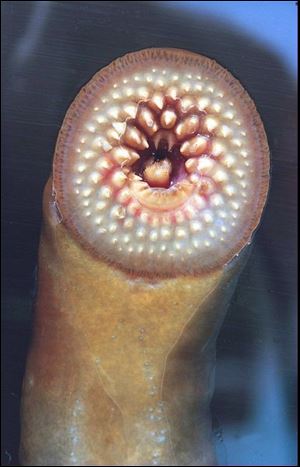
Pests menace Lake Erie
9/29/2003
A vampire-like sea lamprey attached to a piece of glass exposes the teeth it uses to penetrate the scales and skin of a fish in its quest for blood. Sea lampreys, which began entering Lake Ontario in the early 1800s, have virtually wiped out lake trout.
Invasive species - not the chemicals that pollute the air, land, and water - were singled out as Lake Erie's biggest threat a year ago by the U.S. Environmental Protection Agency.
That didn't particularly shock researchers. Slamming the door on dozens of aquatic pests from other parts of the world has been on the Great Lakes agenda for decades. Yet even with heightened security in response to the terrorism attacks of Sept. 11, 2001, some experts fear the problem - which has the potential to wreck the region's ecosystem and economy - will get worse before it gets better.
International trade markets are expected to open up more with Asia in the coming years, creating the potential for different exotics. Plus, they could come in greater bulk if the U.S. Army Corps of Engineers digs a deeper, wider shipping channel. The Corps is exploring that possibility.
“We're going to be getting a whole new set of species,” said David Lodge, a University of Notre Dame aquatic ecologist. “We've got to get ahead of the curve.”
Ships have gotten fast enough to be considered “floating aquariums” he said.
Asia's climate is more similar to North America than to northern Europe, where most of today's exotics hail from. So it only makes sense that microscopic critters from Asia will have even better odds of surviving oceanic voyages, he said.
Hugh MacIsaac, a University of Windsor biology professor, has said increased funding to protect the Great Lakes from terrorism threats could have the dual benefit of helping the United States and Canada become more aggressive in their war on exotic species.
Schoolteachers should help by using more flash cards and other devices to help educate young pupils about which species don't belong, so that the next generation grows up well-versed about the pitfalls. “This is a global threat to bio-diversity,” Mr. MacIsaac said.
Many exotics, such as zebra mussels, are freshwater species that traveled across the Atlantic Ocean in a ship's bottom.
Numerous bills have been passed by Congress over the years to attack the problem, including a landmark invasive species act championed by former U.S. Sen. John Glenn (D., Ohio) that for years has required oceanic ships to exchange their ballast water at sea. Saltwater kills off freshwater species in the ballast when that's done properly.
But officials say it's obvious that system hasn't worked as well as it should. Some ships manage not to comply to avoid the time and cost involved. Studies have been conducted on alternatives that include chlorinating ballast water or thermally treating it.
U.S. Rep. Candice Miller (R., Mich.) recently introduced legislation calling for ships to dump 95 percent of their ballast at sea before entering the lake system. The bill was written in part because the U.S. EPA decided it would not require ships to have permits for discharging their ballast water in the lakes.
Ms. Miller said her bill would reinforce the U.S. Coast Guard's authority to inspect ship tanks. The U.S. Coast Guard requires ballast exchanges. The Canadian Coast Guard does not.
Zebra mussels and quagga mussels, a larger aquatic cousin that has displaced many of those mollusks, have cost the Great Lakes region billions of dollars by clogging water intake pipes. They're being investigated for causing biological changes, from the re-emergence of toxic algae in western Lake Erie to various types of botulism in eastern Lake Erie. The latter has killed thousands of fish and birds since 1999.
One of the most notorious invaders is the vampire-like sea lamprey, which sucks the blood from lake trout. Sea lampreys began entering Lake Ontario in the early 1800s. In the early 1900s, when the Welland Canal was built to help ships get past Niagara Falls, lamprey had an easy pathway into the lakes.
Lampreys virtually wiped out lake trout. Years of intense field work followed to get the lamprey under control with chemical treatments and other means. This summer, the big news from the Minnesota Department of Natural Resources was that - for the first time in many years - it wouldn't have to stock Lake Superior with lake trout. The state agency felt the trout population finally was coming around enough to sustain itself there.
But other threats loom for the Great Lakes. Asian carp, which can grow to 85 pounds, are now seen as one of the biggest, because of their voracious appetites and extreme sensitivity to vibration. They've been known to leap out of the water and hurt boaters. Arkansas fish hatcheries imported them to eat pond scum, but many have escaped into the Mississippi River and moved north. An electric barrier and other efforts are under way to keep them from entering the Great Lakes via Lake Michigan.
In some cases, exotic species send a higher concentration of chemicals up the human food chain. That's happened in the case of round gobies, an invader that feeds on zebra mussels. Scientists have learned the fatty tissue of those species collects pollution that gets passed along to some of the bigger fish that people eat.
The Associated Press contributed to this report.